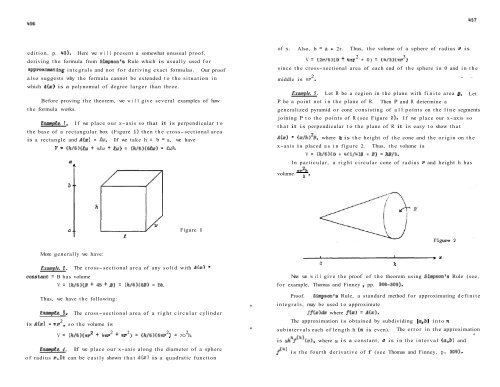Vol. 8 No 7 - Pi Mu Epsilon
Vol. 8 No 7 - Pi Mu Epsilon
Vol. 8 No 7 - Pi Mu Epsilon
Create successful ePaper yourself
Turn your PDF publications into a flip-book with our unique Google optimized e-Paper software.
edition, p. 43). Here we will present a somewhat unusual proof,<br />
deriving the formula from Simpson's Rule which is usually used for<br />
approximating integrals and not for deriving exact formulas. Our proof<br />
also suggests why the formula cannot be extended to the situation in<br />
which A(x) is a polynomial of degree larger than three.<br />
Before proving the theorem, we will give several examples of how<br />
the formula works.<br />
Example. 1. If we place our x-axis so that it is perpendicular to<br />
the base of a rectangular box (Figure 1) then the cross-sectional area<br />
is a rectangle and A(x) = -&i>.<br />
If we take h = b - a, we have<br />
V = (h/6)(£ + 4to + to) = (h/6)(6to) = &*.<br />
of x. Also, b - a = 2r. Thus, the volume of a sphere of radius r is<br />
2 3<br />
V = (2~/6)(0 + 4nr + 0) = (4/3)(irr )<br />
since the cross-sectional area of each end of the sphere is 0 and in the<br />
2 * .-<br />
middle is m .<br />
Example. 5. Let R be a region in the plane with finite area B. Let<br />
P be a point not in the plane of R.<br />
Then P and R determine a<br />
generalized pyramid or cone consisting of all points on the line segments<br />
joining P to the points of R (see Figure 2). If we place our x-axis so<br />
that it is perpendicular to the plane of R it is easy to show that<br />
A(x) = (z/h)~, where h is the height of the cone and the origin on the<br />
x-axis is placed as in figure 2.<br />
V = (h/6)(0 + 4(1/4)B t B) = hB/3.<br />
Thus, the volume is<br />
In particular, a right circular cone of radius r and height h has<br />
nrLh<br />
volume 3 -<br />
Figure 1<br />
More generally we have:<br />
Example. 2. The cross-sectional area of any solid with A(x) =<br />
constant = B has volume<br />
V = (h/6)(B + 4B + B) = (h/6)(6B) = Bh.<br />
Thus, we have the following:<br />
EW&C 3' The cross-sectional area of a right circular cylinder<br />
2<br />
is A(x) = try , so the volume is<br />
2 2 2 2<br />
V = (h/6)(w2 + 4nr + nr ) = (h/6)(6nr ) = TO h.<br />
E ~ p 4. h If we place our x-axis along the diameter of a sphere<br />
of radius r,it can be easily shown that A(x) is a quadratic function<br />
<strong>No</strong>w we will give the proof of the theorem using Simpson's Rule (see,<br />
for example, Thomas and Finney , pp. 308-309).<br />
Proof. Simpson's Rule, a standard method for approximating definite<br />
integrals, may be used to approximate<br />
ff(x)dx where f(x) = A(x).<br />
The approximation is obtained by subdividing [a,b] into n<br />
subintervals each of length h (n is even). The error in the approximation<br />
is vh4f4(c), where is a constant, c is in the interval (a,b) and<br />
f(4) is the fourth derivative of f (see Thomas and Finney, p. 309).<br />
A
















